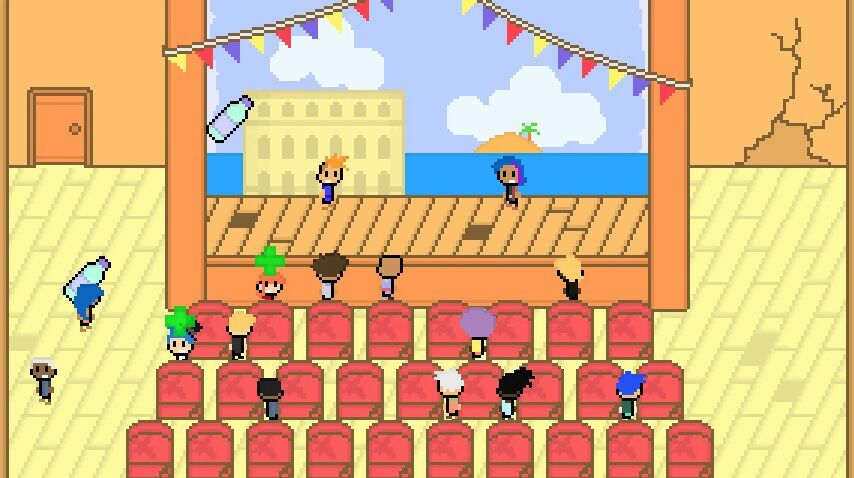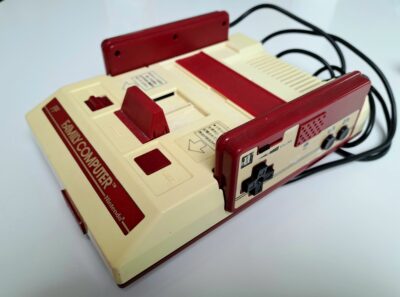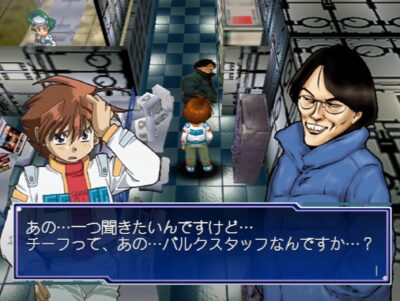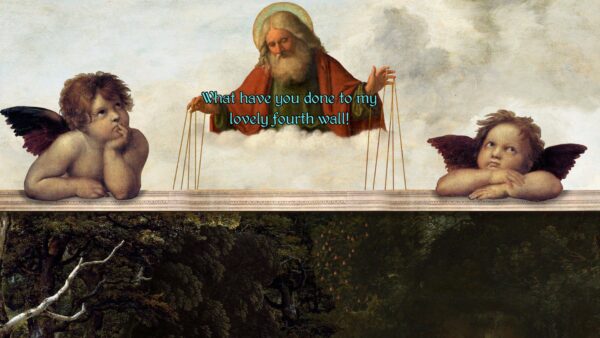
My play about a bear visiting a market in search of a pile of cash hasn’t gone down well, and now the jeering audience is pelting me and my co-star with armfuls of bottles, rocks, and rotten fish. Such is the life of an actor in The Rainsdowne Players, a likeably lo-fi RPG about two would-be thespians trying to launch their own theatre in a rough part of town. The roof’s leaking and the clientele are rowdy, but by talking to individual audience members and tailoring performances to their liking, it’s possible to gradually amass a loyal following and, as ticket sales grow, use the funds to restore the theatre to its former glory.
Created by Rutland-based solo developer, Steve O’Gorman, The Rainsdowne Players establishes a wonderfully everyday tone: its events take place in a single town rather than a sprawling fantasy world, while its inhabitants talk about such mundane things as what they had for dinner or the science project they’re currently working on.
These conversations do, however, offer useful clues to the kinds of performances the townsfolk would like to see, which leads to the other major parts of the game: planning out your play’s story, by selecting characters, scenarios and outcomes from a set of collectible cards, and then actually performing the play – triggering a rhythm-action mini-game where you press the left and right keys to dodge incoming projectiles lobbed by the audience. The narrow focus not only gives The Rainsdowne Players its homespun charm, but also helped keep the project manageable enough for O’Gorman to complete in his spare time.

“The carefully managed scope of the game made the work–life balance thing workable,” O’Gorman says of crafting his miniature RPG world.
“I’m certain every solo indie developer has at some stage started plotting their 70-hour RPG opus that never made it past the first intricately designed town,” O’Gorman tells us. “Limiting my scope to a game set within a single neighbourhood which was just big enough to contain everything my game needed was a crucial decision to making this thing manageable.”
Before The Rainsdowne Players, O’Gorman had spent several years working on smaller iPhone games in his spare time; it was in 2016 that he decided to make the leap from smartphone strategy apps to a larger indie game he could sell on Steam.
Stagecraft
“I’ve been designing and making small games for about 12 years,” O’Gorman says. “Most of them are small iPhone games, now currently lost in time, as I got too cheap to continue paying for the Apple Developer membership in order for them to remain on the App Store. The Rainsdowne Players is my first attempt at a biggish project, mainly because I felt like I should try to make at least one game of this size sometime in my life.”
By carving out an hour each day between his job as a web developer and other daily tasks, O’Gorman worked away on the project for the next two years or so, using tools like Paint.NET for creating his pixel sprites.
“I’m always working on art, programming, and design at the same time,” O’Gorman says, “so there’s usually always something tangible to show for an evening’s work, even if it’s just a funny couple of lines of dialogue. I don’t get bogged down doing a whole week of art or a whole week of script writing.”

“All the pixels are super-chunky to hide my lack of artistry,” O’Gorman says. We rather like the chunky sprite design, in fairness.
Setting goals has helped maintain a sense of progress, says O’Gorman (“I had a lot of key scenes sketched out on paper or just in my head that I spent, in some cases, years looking forward to being able to finally put into reality”), but the game’s development has still thrown up a few challenges from time to time.
“Even at this scale, building a not-entirely-linear RPG means keeping tabs on a lot of moving parts,” O’Gorman tells us. “Which NPC needs to be where, at what time of day, what quest lines affect the world, and so on.”
The result is a game that takes in a range of influences, from JRPGs to rhythm-action games, but works them into a title with its own atmosphere and humour. (A particular highlight: the delightfully sour Marji, who sells tickets at the box office and says things like, “Profits have been surprisingly existent so far.”)
“There’s definitely a lot of Paper Mario DNA in there, in that I wanted a colourful, miniature world with lots of silly, humorous characters,” O’Gorman says. “Majora’s Mask is an influence, too, as far as wanting every NPC to be unique, with an adherence to a daily schedule. As far as story and characters are concerned, I was inspired by modern animated shows like Steven Universe, which do great things with character-driven and emotional storytelling in settings where the stakes don’t have to be life or death.”

Plays are constructed from cards garnered from the audience – and there are loads to collect.
The Rainsdowne Players launched on Steam in September 2018, but with the sheer volume of other indie games floating around, O’Gorman describes the process of selling a game on the platform as being “a bit like throwing a pebble in the sea.”
In February this year, though, The Rainsdowne Players landed on Nintendo Switch – a console that’s become something of a refuge for unusual indie games. “Switch sales might help decide whether I’ll ever make another game requiring a three-year commitment like this one,” O’Gorman says, “but I’ll still keep working away at something.”
At the time of writing, however, there’s good news on the Switch sales front: O’Gorman announced via Twitter that The Rainsdowne Players sold more copies on its first day on the Nintendo eShop than it had during its entire lifetime on Steam up to that point. O’Gorman’s chaotic theatre RPG has, it seems, finally found the appreciative audience it deserves.
Switched on
Getting a game on the Nintendo eShop is a goal for many an indie developer, so what was O’Gorman’s process? “Pitching your game for Switch involves finding the right balance between a colourful pitch about the unique and fun aspects, and also some more businesslike assurances,” he tells us. “I think it helped that the game was already complete and I had some positive review quotes to include in the pitch email. Also, sitting on the pitch email for a whole month because you’re nervous about rejection gets you nowhere!”





